Human transbodies that interfere with the functions of Ebola virus VP35 protein in genome replication and transcription and innate immune antagonism
- PMID: 29568066
- PMCID: PMC5864874
- DOI: 10.1038/s41426-018-0031-3
Human transbodies that interfere with the functions of Ebola virus VP35 protein in genome replication and transcription and innate immune antagonism
Abstract
Small molecular inhibitors and passive immunization against Ebola virus disease (EVD) have been tested in animal models, including rodents and non-human primates, as well as in clinical trials. Nevertheless, there is currently no Food and Drug Administration (FDA)-approved therapy, and alternative strategies must be pursued. The aim of this study was to produce cell-penetrable human single-chain antibodies (transbodies) that are able to interfere with the activities of interferon inhibitory domain (IID) of the VP35 protein, a multifunctional virulence factor of Ebola virus (EBOV). We speculated that effective VP35-IID-specific transbodies could inspire further studies to identify an alternative to conventional antibody therapies. Phage display technology was used to generate Escherichia coli-derived human single-chain antibodies (HuscFvs) that bind to IID. HuscFvs were linked to nona-arginine (R9) to make them cell penetrable. Transbodies of transformed E. coli clones 13 and 3, which were predicted to interact with first basic patch residues (R9-HuscFv13), central basic patch, and end-cap residues (R9-HuscFv3), effectively inhibited EBOV minigenome activity. Transbodies of E. coli clones 3 and 8 antagonized VP35-mediated interferon suppression in VP35-transduced cells. We postulate that these transbodies formed an interface contact with the IID central basic patch, end-cap, and/or residues that are important for IID multimeric formation for dsRNA binding. These transbodies should be evaluated further in vitro using authentic EBOV and in vivo in animal models of EVD before their therapeutic/prophylactic effectiveness is clinically evaluated.
Conflict of interest statement
The authors declare that they have no conflict of interest.
Figures
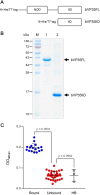

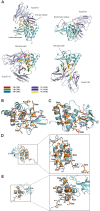
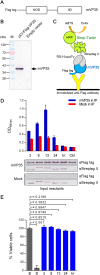
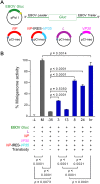
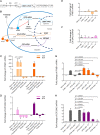
Similar articles
-
Human transbodies to VP40 inhibit cellular egress of Ebola virus-like particles.Biochem Biophys Res Commun. 2016 Oct 14;479(2):245-252. doi: 10.1016/j.bbrc.2016.09.052. Epub 2016 Sep 13. Biochem Biophys Res Commun. 2016. PMID: 27638305
-
Insights into Ebola Virus VP35 and VP24 Interferon Inhibitory Functions and their Initial Exploitation as Drug Targets.Infect Disord Drug Targets. 2019;19(4):362-374. doi: 10.2174/1871526519666181123145540. Infect Disord Drug Targets. 2019. PMID: 30468131 Review.
-
Basic residues within the ebolavirus VP35 protein are required for its viral polymerase cofactor function.J Virol. 2010 Oct;84(20):10581-91. doi: 10.1128/JVI.00925-10. Epub 2010 Aug 4. J Virol. 2010. PMID: 20686031 Free PMC article.
-
Transcriptional Analysis of Lymphoid Tissues from Infected Nonhuman Primates Reveals the Basis for Attenuation and Immunogenicity of an Ebola Virus Encoding a Mutant VP35 Protein.J Virol. 2021 Feb 24;95(6):e01995-20. doi: 10.1128/JVI.01995-20. Print 2021 Feb 24. J Virol. 2021. PMID: 33408171 Free PMC article.
-
Evasion of interferon responses by Ebola and Marburg viruses.J Interferon Cytokine Res. 2009 Sep;29(9):511-20. doi: 10.1089/jir.2009.0076. J Interferon Cytokine Res. 2009. PMID: 19694547 Free PMC article. Review.
Cited by
-
Relevance of Ebola virus VP35 homo-dimerization on the type I interferon cascade inhibition.Antivir Chem Chemother. 2019 Jan-Dec;27:2040206619889220. doi: 10.1177/2040206619889220. Antivir Chem Chemother. 2019. PMID: 31744306 Free PMC article.
-
Computational Study on Potential Novel Anti-Ebola Virus Protein VP35 Natural Compounds.Biomedicines. 2021 Nov 30;9(12):1796. doi: 10.3390/biomedicines9121796. Biomedicines. 2021. PMID: 34944612 Free PMC article.
-
Frontier Therapeutics and Vaccine Strategies for SARS-CoV-2 (COVID-19): A Review.Iran J Public Health. 2020 Oct;49(Suppl 1):18-29. doi: 10.18502/ijph.v49iS1.3666. Iran J Public Health. 2020. PMID: 34268202 Free PMC article. Review.
-
Potential approaches to combat COVID-19: a mini-review.Mol Biol Rep. 2020 Dec;47(12):9939-9949. doi: 10.1007/s11033-020-05988-1. Epub 2020 Nov 13. Mol Biol Rep. 2020. PMID: 33185828 Free PMC article. Review.
-
Microstructure, pathophysiology, and potential therapeutics of COVID-19: A comprehensive review.J Med Virol. 2021 Jan;93(1):275-299. doi: 10.1002/jmv.26254. Epub 2020 Jul 15. J Med Virol. 2021. PMID: 32617987 Free PMC article. Review.
References
MeSH terms
Substances
LinkOut - more resources
Full Text Sources
Other Literature Sources
Medical
Miscellaneous
